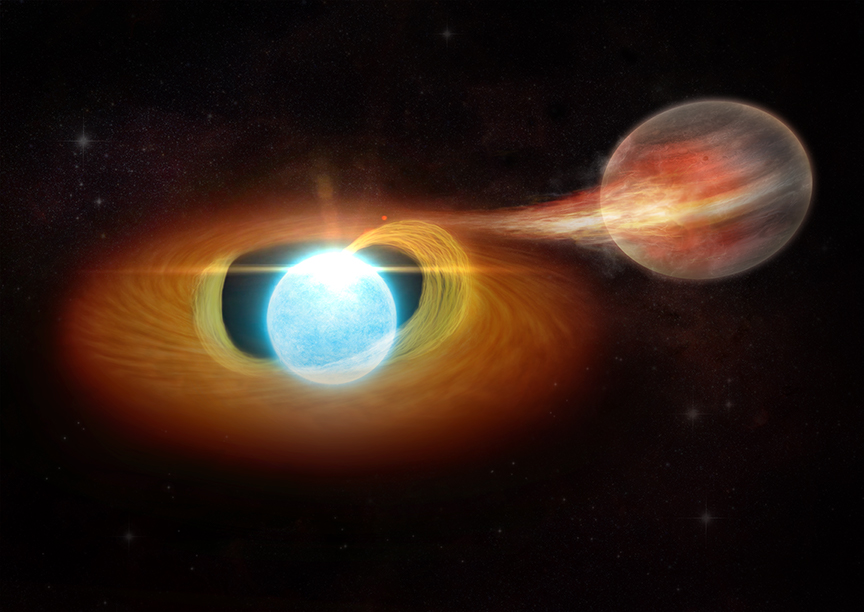On fire and in the process of breakind up by its star companion
Found a system formed by a white dwarf star and a small object, possibly a planet, so close that the second is scorched by the star's radiation, causing its atmosphere to evaporate
All stars with a mass less than eight times that of the Sun will end their lives as planetary nebulae, formed by a white dwarf star -the "bare" core of the star after the expulsion of its outer layers- surrounded by a fluorescent envelope. In a period of about twenty to thirty thousand years, the nebula dissipates and the brightness of the central star will fade. However, this scenario can admit other figures: an international scientific group, in which the Institute of Astrophysics of Andalusia (IAA-CSIC) participates, has found an object around a white dwarf that is receiving incessant bursts of heat and radiation, and that it is in the process of rupture due to the strong gravitational pull of its partner.
A team of scientists used NASA's Chandra X-ray Observatory and ESA's XMM-Newton to investigate some unusual X-ray activity in three white dwarf stars. Typically, white dwarfs give off low-energy X-rays, which researchers saw in their sample. However, these white dwarfs also had surprisingly bright X-ray emission at higher energies.
One of the white dwarfs stood out among this group. The white dwarf KPD 0005+5106 had high-energy X-ray emission that was regularly increasing and decreasing in brightness every 4.7 hours. This recurring ebb and flow of X-rays indicates that KPD 0005+5106 has an object in orbit around it — either a very low-mass star or a planet.

"We didn't know this white dwarf had a companion before we saw the X-ray data," said You-Hua Chu of the Institute of Astronomy and Astrophysics, Academia Sinica (ASIAA) in Taiwan, who led the study. "We've looked for the companion with optical light telescopes but haven't seen anything, which means it is a very dim star, a brown dwarf, or a planet."
KPD 0005 + 5106, located in our Galaxy about 1,300 light years from Earth, is one of the hottest white dwarf stars known, with a surface temperature of about 200,000 degrees Celsius. By comparison, the surface of the Sun is about 5,500 degrees.
"This companion object is about 800,000 kilometers from the white dwarf, only one-thirtieth of the distance from Mercury to the Sun -says Jesús Toalá, a researcher at the National Autonomous University of Mexico who participates in the work-. Whatever this object is, it is receiving huge doses of very energetic radiation".
The researchers looked at what would happen if this object was a planet with the mass about that of Jupiter, a possibility that agrees with the data more readily than a dim star or a brown dwarf. In their models, the white dwarf would pull material from the planet onto the white dwarf, a process that the planet could only survive for a few hundred million years before eventually being destroyed. This stolen material swirls around the white dwarf, which glows in X-rays that Chandra and XMM-Newton detected. "We are witnessing the slow disappearance of this object, which is basically being destroyed by constant gravitational forces", points out Martín A. Guerrero, co-author of the Institute of Astrophysics of Andalusia (IAA-CSIC).
The two other white dwarfs were also thought to be solitary objects, but they show similar energetic X-ray emission to KPD 0005+5106. By analogy, this suggests they may also have faint companions, possibly planets.
Recent work, in which the Institute of Astrophysics of Andalusia (IAA-CSIC) has also participated, has shown that a planet can survive the evolution of a white dwarf through its red giant phase. However, this planet orbits its star at a minimum distance of about three times that between the Earth and the Sun, much greater than that observed by You-Hua Chu and his team. Thus, the development of more theoretical models on the evolution of double stars is necessary to understand how a planet or a low-mass star could end up so close to the white dwarf.
Chu et al. Hard X-ray Emission Associated with White Dwarfs. IV. Signs of Accretion from Sub-stellar Companions, The Astrophysical Journal. https://arxiv.org/abs/2102.05035
Instituto de Astrofísica de Andalucía (IAA-CSIC)
Unidad de Divulgación y Comunicación
Silbia López de Lacalle - sll[arroba]iaa.es - 958230676
https://www.iaa.csic.es
https://divulgacion.iaa.csic.es

